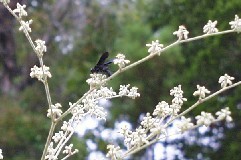Harper's buckwheat facts for kids
Quick facts for kids Eriogonum longifolium var. harperi |
|
|---|---|
 |
|
| Scientific classification |
|
| Kingdom: | Plantae |
| Clade: | Tracheophytes |
| Clade: | Angiosperms |
| Clade: | Eudicots |
| Order: | Caryophyllales |
| Family: | Polygonaceae |
| Genus: | Eriogonum |
| Species: |
E. longifolium
|
| Varietas: |
E. l. var. harperi
|
| Trinomial name | |
| Eriogonum longifolium var. harperi (Goodman) Reveal
|
|
Harper's buckwheat, also known as Harper's umbrella plant, is a special type of plant. Its scientific name is Eriogonum longifolium var. harperi. This plant is a dicot, which means its seeds have two tiny leaves. It belongs to the buckwheat family, called Polygonaceae. You can find it growing in parts of Alabama, Kentucky, and Tennessee. It likes poor shale soil that doesn't have many nutrients.
This plant has a unique life cycle. It stays small and doesn't flower for at least four years. After this time, it grows a tall stalk with flowers. Once it blooms, the plant then dies. Harper's buckwheat is listed as an endangered species in Tennessee. This means it is at risk of disappearing forever.
Contents
Life Cycle of Harper's Buckwheat
Harper's buckwheat has an interesting way of growing. For its first four years or more, it stays in a young, leafy stage. During this time, it doesn't produce any flowers. It just grows leaves close to the ground.
After this long period, the plant finally gets ready to bloom. It sends up a tall stalk. This stalk then produces its small, pretty flowers. Once the plant has flowered and made seeds, its life cycle ends. The plant then dies.
Where Harper's Buckwheat Lives
Harper's buckwheat grows in specific places. It prefers soil that is not very rich in nutrients. This plant is found in only a few areas across three states. These states are Alabama, Kentucky, and Tennessee.
Populations in Alabama
One of the larger groups of Harper's buckwheat plants is in northern Alabama. It grows on land owned by the TVA. Experts believe there are over 700 plants in this area. Here, Harper's buckwheat shares its home with other plants. These include prickly pear (Opuntia species) and false aloe (Manfreda virginica). They all grow together on a calcareous cliff. This means the cliff has a lot of limestone.
Another group of these plants is also in northern Alabama. This area is a special type of habitat called a cedar glade. The Alabama Nature Conservancy protects this land. Many other rare and endangered plants live here too. Some of these include Alabama glade cress (Leavenworthia alabamica) and Tennessee milk vetch (Astragalus tennesseensis).
Status in Tennessee and Kentucky
In Tennessee, there are five small groups of Harper's buckwheat plants. The state has listed it as an endangered species. This means it needs protection to survive.
The situation in Kentucky is less clear. A leading expert, Professor James L. Reveal from the University of Maryland, reported that the Kentucky population might be gone. This means it could be extirpated, or locally extinct.
Protecting Harper's Buckwheat
In 2006, the Alabama Natural Heritage Program studied Harper's buckwheat. They gave it a ranking of G4T2S1. This ranking showed that the plant was "critically imperiled" in Alabama. This means it was in great danger there.
Protecting Harper's buckwheat is important. Its unique life cycle and specific habitat make it special. Efforts by groups like the Nature Conservancy help save these rare plants. They work to protect the land where these plants grow.

